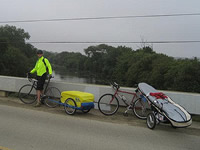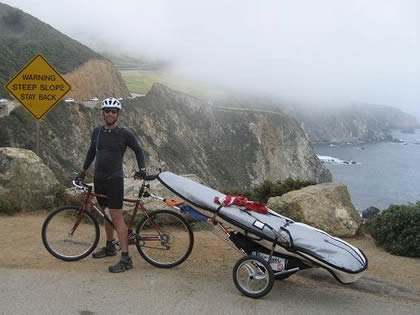The Cumulative Effect
Phoresia is pleased to bring to you the second in a three-piece series about surf travel by bike. Author and traveler Scott Paynton writes about his shifting perspective since the trip.
It’s been over a month since Mike and I biked and surfed down the coast of California. Since then, my perspective on surfing has been changing — not about surfing itself, but all that goes into doing it. I haven’t figured out all of these changes yet, I just know my perspective is changing. The first article of this series was my first musing into this change, and this piece serves as another chance to try to flesh out my individual role in the interconnectedness we have as surfers. I woke up at 5:30 this morning to take advantage of the fun glassy south-west swell that was hitting one of our local spots. This particular spot is 20 miles up the coast from my house. I loaded up my Honda Element with my gear and started out in the early morning hours. As I was enjoying the sun rising anticipating great surf, I passed three homeless people in different spots of my town packing up their belongings as they were waking. It occurred to me, “I’m connected with these people. They are fellow humans, and here I am with my mocha, a couple thousand dollars of gear in my car, and a willingness to burn $10 in gas for a pursuit that is dear to me.”  Now don’t get me wrong, I’m not about to give up surfing if I don’t have to, but something has not been sitting right lately. The homeless people I saw were a reminder of that.
Now don’t get me wrong, I’m not about to give up surfing if I don’t have to, but something has not been sitting right lately. The homeless people I saw were a reminder of that.
In the last article I asked what we all could do as individuals to mitigate our impact on the environment and others. My answer to this question, whether related to surfing or not, keeps boiling down to two words — Consume Less! This idea applies across the board. Drive less, eat less, buy less, use less. There was a discussion in The Surfer’s Path magazine a while back about this idea. The magazine (a fine example of how to produce print media in green ways) often highlights “green” surf gear they like. In response to this feature of the magazine, one reader wrote in saying that perhaps the best option was for us surfers to consume less, instead of simply switching our consumption habits to buying green in order to make ourselves feel good about our purchases. That recommendation has stuck with me.
It’s always been my perspective that I have a pretty modest collection of surf equipment. My quiver consists of five boards, three board bags, two wetsuits, multiple pairs of booties and gloves, countless bars of wax, etc. But, how much do I really need? Mike, my friend who did the bike and surf ride with me, has been teaching me a few lessons about this as of late. To think, he was a former student of mine, and now the student is teaching the teacher.
As I stated before, we had amazing sponsors donate surf equipment for our trip made from the latest in sustainable materials (for a review of this equipment, click here). Most of the equipment arrived before our trip so we could try it out and get used to it. A couple of weeks before the trip Mike called and said that he had gotten to his local spot and forgot his board leash. He asked someone if they would take two of his wetsuits in exchange for a leash. Of course, they did! I asked in surprise, “You traded two wetsuits for a leash?” His response struck me, “Well yeah. Since I got the new one from Matuse for the trip, why do I need more than one wetsuit?” Good question. It should be known, this isn’t the only time he has done this. A friend had given him a mint condition Bonzer shaped by Malcom Campbell himself. When I asked if he was still riding his other board that he deeply loved, he responded, “No, I gave it away to someone who didn’t have a surfboard. Why do I need two boards?” Again, good question. This mentality was taken to a new level when he told me he’s been wanting to give away his Bonzer since Ned McMahon of Homeblown shaped him a beautiful quad-fish out of Biofoam for the bike trip. Again, his question was, “Why do I need two boards?”
Many of us have lived by the misconception that surfing is a “no impact” sport. This may be true when we hit the water, but getting there and the equipment we use do have an impact. We shouldn’t deceive ourselves that our addiction is a no impact pursuit. If we’re willing to admit it, most of us who surf are fortunate enough to belong in a pretty high socio-economic class. We’ve got the time and money to spend pursuing surfing for recreation. With this privilege (and it is a privilege), comes responsibility. But what does this mean for us as individuals connected to each other by one ocean?

Let me put it together as best I can. The sponsors who supported us are raising the bar with the sustainable gear they are producing. In fact, I’m working on an academic peace that speaks to the corporate grassroots activist movement coming from companies like HomeBlown, WaveTribe, Matuse, Matunas, and Trunq. These smaller companies are having a large impact on the larger multi-national surf companies and the ways they produce and sell gear. In my next piece, I will speak directly to surf companies about their role in all of this. But first, let’s talk about us as individuals and our responsibility. What can each of us do?
First, buy less! We are taught that the next piece of gear will help us surf better, make us more comfortable, etc. But the question to ask is, “Do I really need all of this?” I have five boards, but do I really need or use all of them? Second, use your equipment as long as possible. Patagonia has long held this ideal by seeking to produce the longest lasting gear possible. The longer I have gear, the greater length of time between purchases, and the less I consume and throw away. Third, support green companies like those that sponsored our trip. In business, money talks. As consumers, we have a choice of who to buy from, and we speak with our money. The more we buy from green companies, the more companies will seek to achieve sustainable practices. If your local surf shop is not carrying gear from sustainable manufacturers, demand that they do. If they refuse, spend your money elsewhere. Fourth, truly consider your carbon footprint as you look for surf. Use technology that is available to avoid driving. Webcams, cell phones, and computer surf reports have the potential to keep a great deal of people off the road if we use them. When you do drive, carpool. Or, support companies like Quiver Kaddy and Equinox by attaching your boards to your bicycle and cycling to your local break. These steps may seem small, but every bit counts. Surfing is the fastest growing sports industry, so our collective individual steps amount to large-scale impacts.
We surfers have a true connection with each other and the ocean that provides us with some of our greatest pleasures and memories in life. If we are able to work at combining the gifts and resources of multiple people we just might create significant positive change. Change is most often slow and small, and takes the commitment of many people who are willing to keep putting one foot in front of another until we succeed in creating the change we desire. Going back to systems theory in the first article, each of our individual actions impacts others.
Even though the trip is complete, all is not done. If all goes well, Mike and I want to make this an annual trip for others who are interested in making a change by towing their boards behind their bikes rather than carrying them on their cars. Next year we hope to take a relatively small group of people, all of whom will be responsible for fund raising and raising environmental awareness. We want to continue our fund-raising, getting more sophisticated in finding ways to help our fellow brothers and sisters around the world improve their quality of life in some small or large way — a benefit we often take for granted every time we hit our lineup. If you are interested, please feel free to contact us by going to our website at www.bikeandsurfcalifornia.com. If you are interested, we must warn you that the trip is physically hard and mentally demanding, so we are going to do our best to bring along people who are prepared to endure some hard times for the good of the cause.
Good outlook.
How about what we can do #5-
Buy/sell used stuff. Its so easy to find good condition boards or suits for half price on Craigs list. My buddy who is a size medium has been successful in finding nearly new wetsuits in a local used sporting goods shop. Anytime you buy something used, less energy and resources were used to make a new one. But not just in surfing you can find bikes, furniture, just about anything you may need.
The biggest carbon footprint change I have made was moving closer to my job but further from the coast. Used to be 3 miles from the beach and 20 miles from work. Flipped those around and now I can bike to work but have to drive to the surf. But since I can only really surf 1-2 per week it works out for the best and gets in me in better shape riding to work all the time.
Here is a cool collage of several surfers experience with cycling surf trips.
http://surfermag.com/magazine/archivedissues/cracksinpavement/index.html
paddle and pedel on!
Really diggin’ this series.